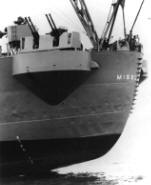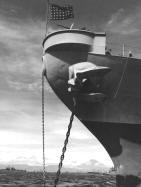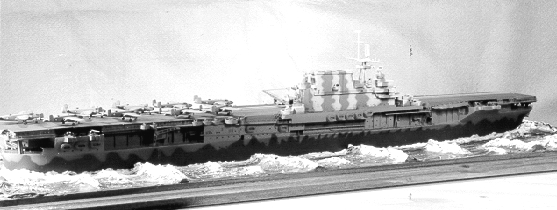|
Toll free 800 - 845-1140 |
|
Shipping
will be added to all orders, we always endeavor to give you the
best rate >>> Click for Rates. |
If you have any
questions or need help email us, call us or click here for HELP

USS Hornet CV-8 Ship
Models
14" long plastic kit
consists of 465 parts on 22 sprues plus waterline plate
for full hull or waterline construction. markings for 1942, measure 12.
Kit# A107 1/700 sale 33.95
The Doolittle Tokyo Raid
The Doolittle Tokyo raid was perhaps the most famous
exploit of the B-25 Mitchell. It was carried out in an attempt to shore up morale on the
home front during the early months of 1942, which was sagging as a result of suffering
defeat after defeat in the Pacific.
Planning for a retaliatory raid on the Japanese home
islands seems to have begun very soon after the attack on Pearl Harbor. Contrary to
general knowledge, Lt. Col. James Doolittle was not the originator of the Tokyo raid
concept. The basic idea of launching medium bombers from the deck of an aircraft carrier
seems to have come from Navy Captain Francis Low, who was on Admiral King's staff. Low
took the idea to Captain Duncan, Admiral King's air officer. Duncan concluded that the
idea was technically feasible and passed it along to his boss. The Admiral was
enthusiastic about it, and on his orders, Capt. Duncan passed the idea along to General
Arnold. General Arnold then sent for his new special projects officer, Lt. Col. James H.
Doolittle, who was already a famous aviator as a result of his exploits with racing
aircraft. Doolittle was enthusiastic about the idea and immediately signed on.
A "Tokyo project" was quickly and secretly
formed. Lt. Col. Doolittle and Captain Duncan were assigned project responsibilities for
their respective services. Lt. Col. Doolittle would lead a picked crew of aviators who
would launch an attack against the Japanese home islands from the deck of the aircraft
carrier USS Hornet. Although it was believed that it was indeed feasible to launch medium
bombers from the deck of an aircraft carrier, it was impossible for these types of planes
to land back on the deck of the carrier once the raid was over. Consequently, plans were
made for the planes to be recovered at prearranged airfields in eastern China at the end
of the raid. From there, the bombers would continue on to Burma and enter service in
General Stilwell's command.
The plan required an aircraft with an overall range of
2400 miles carrying a 2000-pound bombload and capable of taking off from the deck of an
aircraft carrier. The only two possible candidates at the time were the Martin B-26
Marauder and the North American B-25 Mitchell. The B-25 was selected on the basis of its
superior takeoff performance.
At that time, the only B-25s in service were with the
17th Bombardment Group. The 17th Bombardment Group comprised the 34th, 37th and 95th
Squadrons, plus the attached 89th Reconnaissance Squadron. This group had been transferred
from Oregon to South Carolina in order to meet the greater threat from German submarines
operating off the East Coast. 24 B-25Bs were diverted from the 17th Bombardment Group, and
volunteers were recruited, the crews being told only that this was going to be a secret
and very dangerous mission against heavy odds.
Two Mitchells had been flown off the deck of the carrier,
USS Hornet, on February 3, 1942, confirming that the basic concept was feasible. The
volunteers moved to Eglin Field in Florida for training. Still not knowing what kind of
mission they were training for, the crews practiced making takeoffs in as short a distance
as possible. It was found that with a reasonable headwind, a B-25 could get airborne with
a 450-foot run.
Certain modifications had to be made to the B-25Bs to
make them suitable for the mission. Since the raid was going to be made at low level, the
retractable ventral turret was removed, saving about 600 pounds of weight. More fuel was
added to the plane, bringing the total fuel load to 1241 gallons -- 646 gallons in the
wing tanks, 225 gallons in the bomb bay tank, 160 gallons in a collapsible tank carried in
the crawlspace above the bomb bay, 160 gallons in the ventral turret space, and ten
5-gallon cans for refills. The still-secret Norden bombsight was removed, lest it fall
into Japanese hands. It was replaced by a makeshift bombsight that proved more
satisfactory for low level operations. The bomb load consisted of four 500-pound bombs. As
a deterrent against Japanese fighters making stern attacks, a pair of dummy guns in the
form of wooden sticks, painted black, were attached to the extreme rear fuselage,
protruding out the back of the transparent tail cap. Takeoff weight was about 31,000
pounds.
Upon completion of training, the crews left Eglin Field
for McClellan Field in California. On April 1, the crews departed McClellan for Alameda
Naval Air Staion Base near San Francisco. Sixteen B-25Bs were all that could be loaded
onto the Hornet, although all of the crew members that trained for the mission embarked
aboard the carrier in case back-ups were needed. The task force steamed off toward Japan
on April 2.
A chance encounter with a Japanese picket boat forced the
raid to be launched at a distance greater than the 400 miles offshore that had originally
been planned and ten hours ahead of schedule in a rough sea. On April 18, 1942, Lt. Col.
Doolittle's plane took off from the Hornet, followed by the 15 others. They headed for
Japan, which was over 700 miles away.
The Mitchells successfully bombed targets in Kobe,
Yokohama and Nagoya, as well as Tokyo. The bombing altitude was about 1500 feet. No
aircraft were lost over the target. However, bad weather prevented the flyers from finding
their prearranged landing fields in China, and eleven of the crews had to bail out while
four others crash-landed. One B-25B (40-2242) was flown to Vladivostock, Russia where both
the aircraft and crew were interned. Click here for a detailed list of
the Doolittle pilots and crew.
All sixteen B-25s that took part in the mission were
lost, seven men were injured and three were killed. Eight crew members were taken prisoner
by the Japanese. Only four of those eight survived the war. The survivors who had landed
in Japanese-controlled territory were sheltered and attended by courageous Chinese, and
for this the Japanese occupying force in China wrought full vengeance on the local
population.
Doolittle at first told his crews that he thought that
the mission had been a total failure and that he expected a court martial upon his return
to the USA. Although all the aircraft were lost and the damage inflicted during the raid
was minimal, the operation provided an incalculable boost to American morale when just
about everything else in the Pacific was going badly. It also pointed out the
vulnerability of the Japanese homeland to bomber attack, and four first-line fighter
groups were retained in Japan rather than being sent to the Solomon's where they were
urgently needed. Instead of being court-martialed, Doolittle was promoted to Brigadier
General, awarded the Medal of Honor, and assigned a new command with greater
responsibility.
For the 25th anniversary of the Doolittle raid, B-25D-30,
43-3374 (a former F-10 reconnaissance ship) was converted into a replica of Lt. Col.
Doolittle's B-25B 40-2344. This airplane is now on display at the Air Force Museum at
Wright-Patterson AFB in Dayton, Ohio.
Serials:
40-2229/2348 North American B-25B Mitchell
- 2242, 2247, 2249, 2250, 2261, 2267, 2268,
2270, 2278, 2282, 2283, 2292, 2297,
2298, 2302, 2344 were Doolittle
Tokyo raiders, 2344 was Doolittle's plane.
Info from www.b25.net




